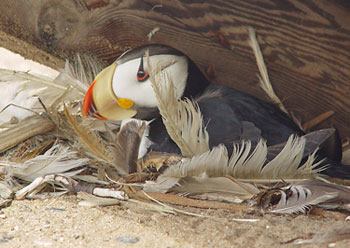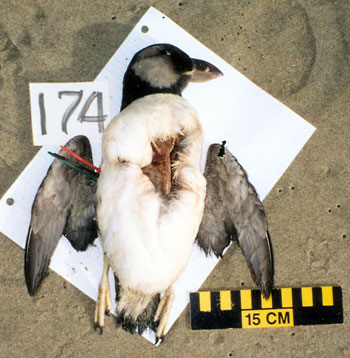It's Not Tufted, It's Horned!
Spring 2005
“It’s certainly a magnificent looking bird, really quite intriguing!” remarked Bert Johnstone of Yachats, OR. It looked remarkably like a Tufted Puffin, but with a light belly and a dark throat collar, it just couldn’t be! “It was certainly something we’d never seen before,” Mike Patton of Ocean Shores, WA told us. This winter, when COASST’s first Horned Puffins washed ashore along the coast of Oregon and Washington, Bert and Mike weren’t the only ones surprised. Bob Paine, a marine ecologist working on Tatoosh Island, WA recently spotted a live Horned Puffin just off the Cape Flattery coast.

Horned Puffin on its nest in Alaska. (Friends of Cooper Island)
So where do Horned Puffins come from? More than 85% of the world’s one million Horned Puffins breed in the Gulf of Alaska, Aleutian Islands, and Bering Sea. Unlike their burrow nesting cousins the Tufted Puffins, Horned Puffins nest in rock crevices hidden among cliffs and beach boulders. In a pinch, they’ll even take advantage of artificial “crevices” such as the piece of scrap wood shown in the photo above. Horned Puffins hatch one chick per year, and mates take turns searching for fish. Sometimes they travel more than 50km in search of food! After a little more than a month, this express sushi delivery service becomes less and less reliable, and the hungry chicks head out to sea.
Just why would puffins travel south from Alaska? Ask any field biologist, and the answer is clear… because it’s really, really cold and miserable up there in the winter! With the fall storms and advancing winter ice, Horned Puffins travel down to the offshore waters of Washington, Oregon, and California. While here, they typically stay more than 180 kilometers offshore, making their living off deep water prey like laternfish and squid.

Adult Horned Puffin found on South Butterclam in the South Coast on February 27th. (Barbara and Mike Patton)
Given their proclivity for offshore waters, Horned Puffins are rarely seen on beached bird surveys. Between 1978 and 2004, Bob Loeffel, retired Oregon Department of Fish and Wildlife employee and long-time beached bird monitor in Lincoln City, Oregon found only 13 Horned Puffins (nine of which were found in March and April of 1980). This year appears to be another spike in Horned Puffin beaching. COASST has recorded six finds from January through April on the South Coast of Washington and in Oregon. BeachWatch, the Gulf of the Farallones National Marine Sanctuary, California, beached bird program also found one Horned Puffin this year. Of our six, five were adults and most looked to be in good condition. Mike Patton said the one they found “didn’t appear to have anything wrong with it, it was just a nice, normal bird. And no signs of starvation either—not like the fulmars last year.”

Juvenile Horned Puffin found on Oregon Mile 196 on February 26th. (Bert Johnstone)
It remains unclear why Horned Puffins came closer to shore this year, as well as way back in 1980. Maybe subtle changes in offshore ocean conditions altered their at-sea distribution. Regardless of the reason for their presence, these COASST findings have caused quite a stir among seabird biologists on the West Coast. John Piatt, a seabird biologist with the USGS Alaska Science Center was mystified and intrigued by our puffin pulse. “I can only guess that more Horned Puffins must have died at sea this year, and based on the months in which they were found, whatever the cause was seemingly widespread. Truthfully, wintering Horned Puffins are somewhat of a black box—it’s unfortunate that COASST doesn’t exist in Alaska, so we could have a better idea of the trends of seabird mortality West Coast wide.”
With more than 80 species accounted for, it gets harder and harder to add to the COASST species list. So the Horned Puffin is a truly exciting addition for this year!